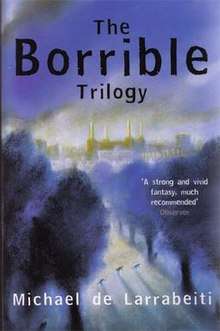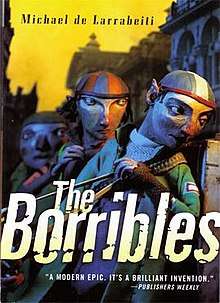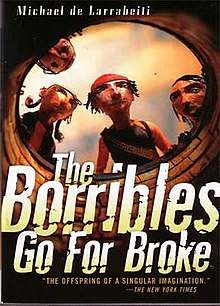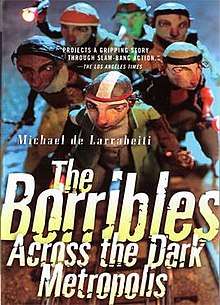The Borrible Trilogy
The Borrible Trilogy is a series of young adult books written by English writer Michael de Larrabeiti. The three volumes in the trilogy are The Borribles, The Borribles Go For Broke, and The Borribles: Across the Dark Metropolis.
 | |
| Author | Michael de Larrabeiti |
|---|---|
| Cover artist | Liz Pyle |
| Country | United Kingdom |
| Language | English |
| Series | The Borrible Trilogy |
| Genre | Fantasy literature |
| Publisher | Tor Books |
Publication date | 2003 (trilogy edition) |
| Media type | Print (hardback & paperback) |
| Pages | 726 pp (2003 Tor UK Edition) |
| ISBN | 0-330-49085-0 |
| OCLC | 59372992 |
The Borribles' antagonists, the Rumbles, who play a significant part in the first book, are satires of perennial children's favourites The Wombles.[1]
The scheduled release of the third book coincided with the English riots of 1985, and because of the strong anti-authoritarian theme, the publishers took the decision not to publish it.[2] The books went out of print but have been republished as a single volume. In June 2002 the trilogy was printed in the UK by Pan Macmillan as a trade paperback with an introduction by China Miéville; in April 2003, the UK branch of Tor Books reissued the trilogy in a smaller paperback volume. Tor released the trilogy as three separate paperback volumes in the US in late 2005.
The world of the Borribles
The trilogy is set in the large city of London. Borribles are runaway children, who eventually become "Borribled," when they wake up and find their ears have become pointed. Visually very similar to the mischievous elves and pixies of English folklore, Borribles wear woolen hats pulled low over their ears to avoid being easily identified by the police "Woollies". The Woollies believe that the Borribles' freedom is a threat to the social order and will clip the ears of any Borrible in their custody. If their ears are not clipped, Borribles will maintain the appearance of a child forever and cease to physically age. Being caught by the police is a prospect worse than death for Borribles as it will signify the end of their lifestyle and they will become a boring, adventureless adult.
Borribles are skinny, scruffy, and tough; at least at first they appear to have nothing to do with money, and steal what they need to survive. They generally live in abandoned houses, though they will live wherever they can, existing on the edge of the adult world. Borribles aren't given their names at birth; they earn them through an adventure of some sort.
They have many saying and practices such as "Fruit of the barrow is enough for a Borrible," "Never stand behind a door when there's someone coming through the other side," "It is sad to pass through life without one good adventure," and "It is better to die young than to be caught." How long Borribles can live is never made quite clear. One character in The Borribles speaks of having been Borribled in the time of "the old queen".
Book 1: The Borribles

The Borribles (occasionally known as The Borribles: The Great Rumble Hunt) is the first book in Michael de Larrabeiti's Borrible Trilogy. It was first published in the United Kingdom in 1976 by The Bodley Head, and in the United States in 1978 by Macmillan Inc., New York. It was named one of the Best Books for 1978 by the American Library Association, and was shortlisted for the Whitbread Awards and the Other Award.
Plot summary
The stories begin with the discovery by the Battersea Chief-Lookout, Knocker, of a Rumble in Battersea Park. The Rumbles are rat-like creatures that live in an underground bunker in Rumbledom, and are hated by the Borribles for their riches, power, and haughtiness. Fearing a full-scale invasion of Battersea, each of the Borrible tribes across London send their best and brightest unnamed members to form an elite hit squad, known as the Magnificent Eight or the Adventurers, with the purpose of infiltrating the Rumble bunker and eliminating the eight members of the Rumble High Command.
Rumbles are clearly a parody of the popular children's characters, the Wombles of Wimbledon Common. On the way the Borribles also meet a particularly vicious parody of Steptoe and Son (which was one of the most popular shows on TV at the time) in the form of Dewdrop, a former Borrible, and his son Ernie.
The Adventurers are each assigned the name of the individual target of the High Command that they are to assassinate: Napoleon Boot, the suspicious and cynical Borrible; Chalotte, the tough and brave girl Borrible; Vulgarian (Vulge), frail-looking, but "tough as nails"; Bingo, always cheerful; Sydney, another female and an animal-lover; Stonks, strong and kind-hearted; Torreycanyon, light-hearted with a knack for mechanics; Orococco, the jovial, black Borrible. Napoleon, Chalotte, Sydney, Vulge, Bingo, Stonks, Torreycanyon, and Orococco set out to squash the Rumble threat – but other Borribles have secret agendas and personal vendettas of their own which create an even greater threat than the Rumbles ever were. The supposedly straightforward adventure dominoes into a desperate fight for the very existence of Borrible life.
Book 2: The Borribles Go For Broke

The Borribles Go For Broke was first published in 1981 by The Bodley Head in the United Kingdom.
Plot summary
Following the adventures of "The Great Rumble Hunt" in the first volume of the trilogy, the second volume begins with the surviving adventurers' discovery that Sam the horse is still alive. In attempting to rescue him the Borribles are lured into danger both by the newly established Special Borrible Group (SBG), a branch of the police determined to wipe out the Borribles and their way of life, and by one of their own – Spiff, whose motives behind the mission to Rumbledom are slowly revealed.
All this leads the Borribles deep into Wendle territory beneath the streets of Wandsworth, and down into a shifting tunnel of mud dug deep beneath the mudflats of the Wendle River.
Book 3: The Borribles: Across the Dark Metropolis

The Borribles: Across the Dark Metropolis was first published in 1986 by Pan Books in the United Kingdom.
Plot summary
In The Borribles: Across the Dark Metropolis, Battersea is no longer safe for a Borrible. The SBG (an allusion to the Special Patrol Group), a section of the London police driven on by the fanatical Inspector Sussworth (an allusion to the sus laws) and dedicated to finding Borribles and clipping their ears is determined to wipe them out. The Borribles decide to escort Sam the horse to safety in Neasden and then return to the old way of life of independence and freedom. They begin their journey Across the Dark Metropolis, a journey that tests the courage and cunning of the Adventurers to the limits.
The Borrible Trilogy in translation
The Borrible Trilogy is, as of 24 July 2006, in print in English in both the United States and the United Kingdom:
- In the UK: The Borrible Trilogy. London: Tor, 2003. ISBN 0-330-49085-0.
- In the US:
- The Borribles. New York: Tor, 2005. ISBN 0-7653-5005-X.
- The Borribles Go For Broke. New York: Tor, 2005. ISBN 0-7653-5006-8.
- The Borribles: Across the Dark Metropolis. New York: Tor, 2005. ISBN 0-7653-5007-6.
The Borrible Trilogy is also in print in the following languages:
- German:
- Die Borribles Auf zur Großen Rumbeljagd (translation of Book 1). Trans. Joachim Kalka. ???: Hobbit, 1996. ISBN 3-608-87511-5
- Die Borribles Im Labyrinth der Wendels (translation of Book 2). Trans. Joachim Kalka. ???: Hobbit, 1996. ISBN 3-608-87512-3
- Die Borribles Die Schleppnetzfahndung (translation of Book 3). Trans. Joachim Kalka. ???: Hobbit, 1996. ISBN 3-608-87513-1
- French:
- Les Zorribles (translation of Book 1). Trans. Alain Robert. Nantes: Librairie l'Atalante, 1994. ISBN 2-905158-87-5
- Gare Aux Zorribles (translation of Book 2). Trans. Alain Robert. Nantes: Librairie l'Atalante, 1995. ISBN 2-84172-004-7
- Les Zorribles Dans La Nuit (translation of Book 3). Trans. Alain Robert. Nantes: Librairie l'Atalante, 1996. ISBN 2-84172-023-3
- Italian
- I Borrible: Attacco a Rumbledonia (translation of Book 1). Trans. Annalisa Di Liddo. Roma: Fanucci, 2006. ISBN 88-347-1172-6.
- I Borrible: Alla riscossa (translation of Book 2). Trans. Annalisa Di Liddo. Roma: Fanucci, 2006. ISBN 88-347-1231-5.
- Japanese
The Borrible Trilogy has been in print in the following languages, but is currently out of print:
- Spanish
- Los Borribles (translation of Book 1). Trans. Joaquín Vidal. ???: Fontanella, 1984. ISBN 84-244-0527-7.
- Swedish
- Borriblarna och stora rumlarjakten (translation of Book 1). Trans. Sven Christer Swahn. Stockholm: Liber Förlag, 1983. ISBN 91-38-90273-7
- Borriblarna flyr för livet (translation of Book 2). Trans. Sven Christer Swahn. Stockholm: Liber Förlag, 1983. ISBN 91-38-90274-5
- Danish
- Boriblerne slår igen (translation of Book 1). Trans. Jørn E. Albert. Copenhagen: Forum, 1982. ISBN 87-553-1110-5
Film adaptation
The film rights for The Borrible Trilogy have been optioned by several film studios and producers since the release of the first book. The first major studio that optioned the film rights was the Walt Disney Pictures/Touchstone Pictures. Touchstone Pictures hired writer Mark Andrus to write an adaptation.
The film rights were also optioned by Eric Fellner and Tim Bevan´s Working Title Films and in 2004 CUBA Pictures, the film development arm of literary agents Curtis Brown,[3] who also represented Michael De Larrabeiti.
Parallels
The members of the High Command of Rumbles correspond directly to one of the main characters of The Wombles:
- Vulgarian (Great Uncle Bulgaria)
- Bingo (Bungo)
- Chalotte (Madame Cholet)
- Torreycanyon (Tobermory)
- Orococco (Orinoco)
- Stonks (Tomsk)
- Napoleon Boot (Wellington)
- Sydney (Miss Adelaide)
Reception
Dave Langford reviewed The Borrible Trilogy for White Dwarf #42, and stated that "The Borribles' underground society is nicely imagined, and the heroisms, treacheries and callousness follow logically from the way Borribles are. Without going all preachy, the author makes it clear that this kind of fun adventure is liable to get you killed: half the main characters are nastily betrayed and die futilely. As well as considerable imaginative flair, The Borribles has the ring of truth."[4]